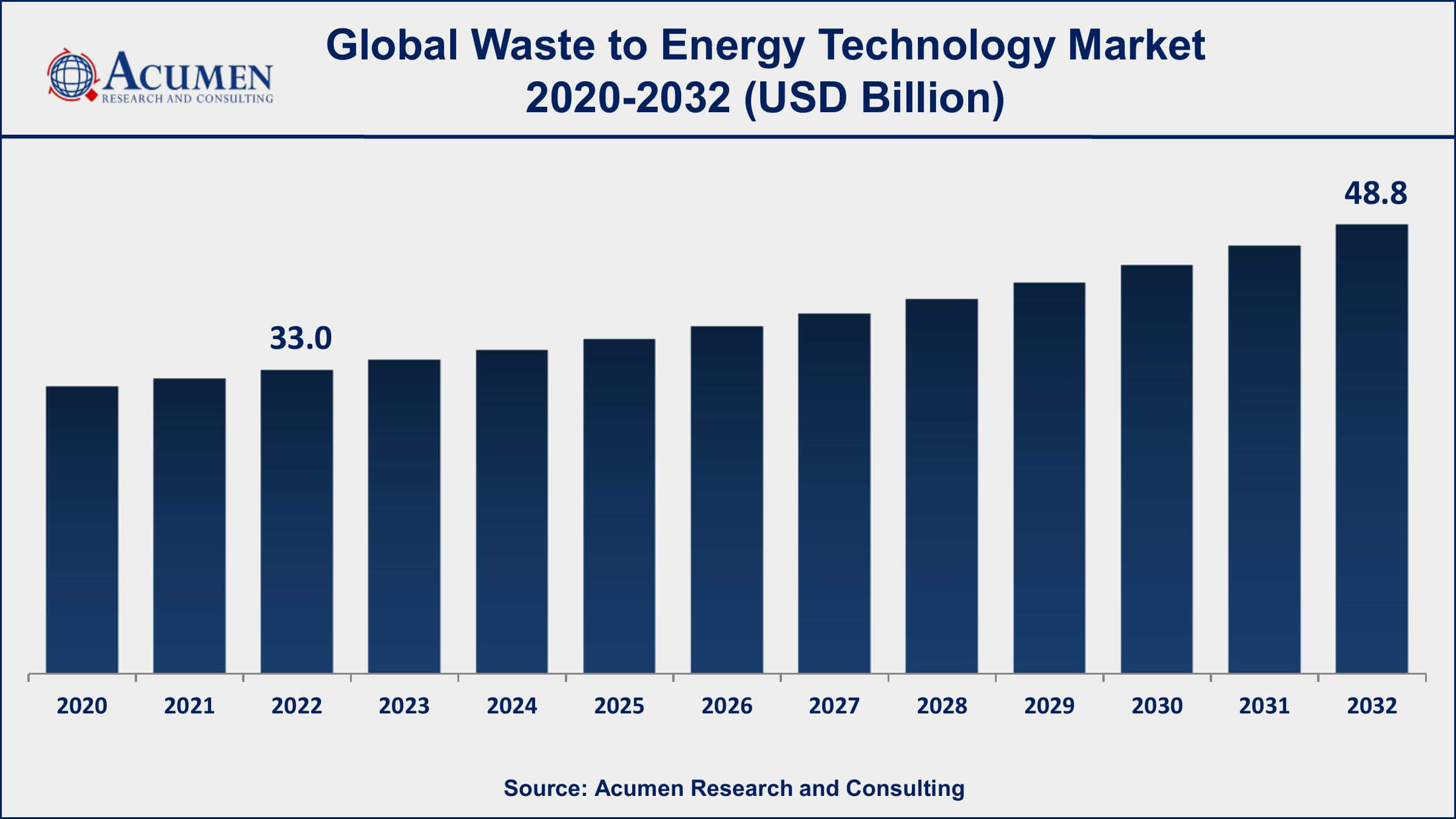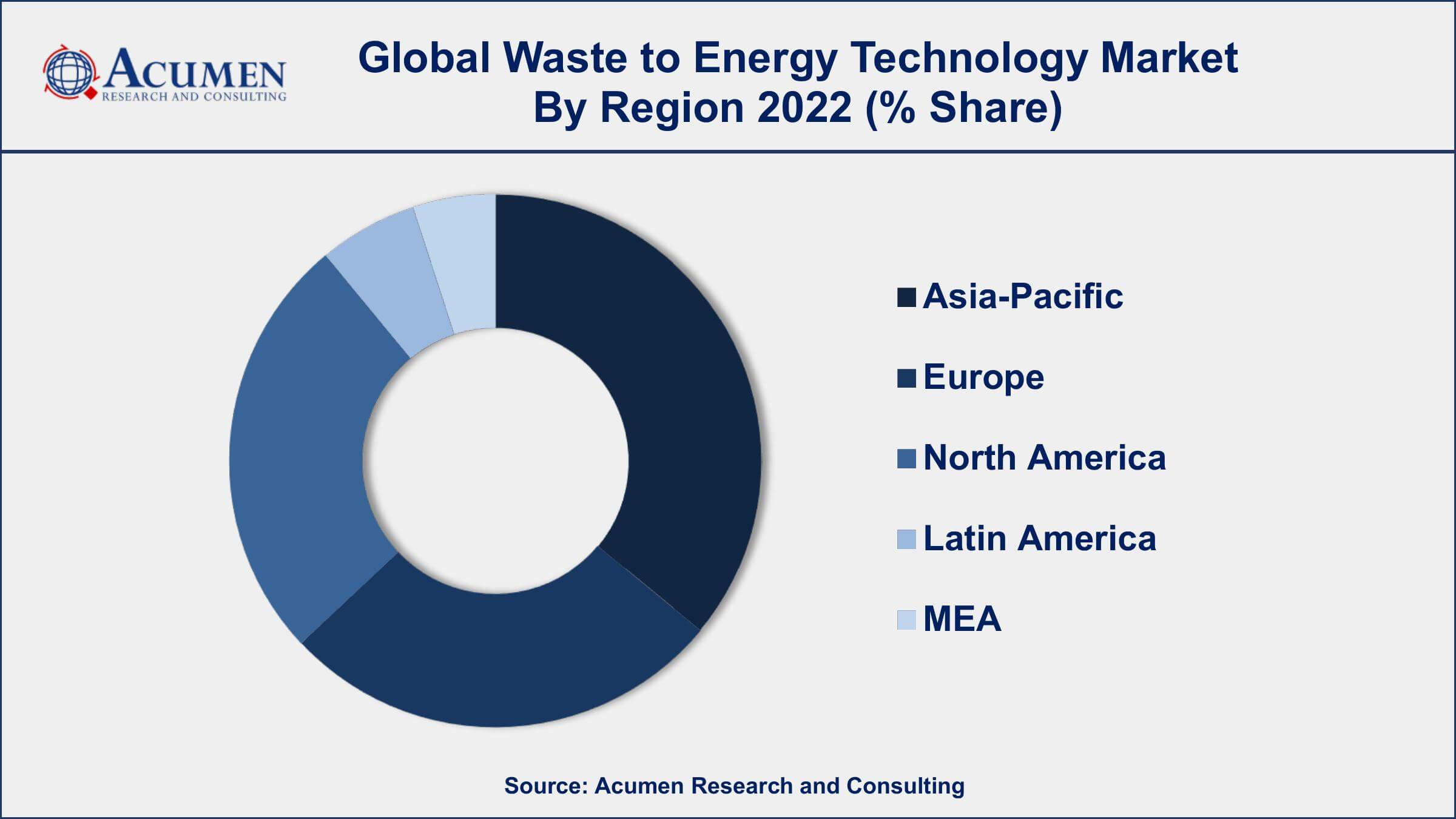Waste To Energy Technology Market | Acumen Research and Consulting
Waste to Energy Technology Market Size - Global Industry, Share, Analysis, Trends and Forecast 2023 - 2032
Published :
Report ID:
Pages :
Format :
The Waste to Energy Technology Market Size accounted for USD 33.0 Billion in 2022 and is projected to achieve a market size of USD 48.8 Billion by 2032 growing at a CAGR of 4.1% from 2023 to 2032.
Waste to Energy Technology Market Report Key Highlights
- Global waste to energy technology market revenue is expected to increase by USD 48.8 Billion by 2032, with a 4.1% CAGR from 2023 to 2032
- Asia-Pacific region led with more than 40% of waste to energy technology market share in 2022
- According to the International Energy Agency (IEA), waste-to-energy facilities generate around 2% of the world's electricity
- According to the United States Environmental Protection Agency (EPA), as of 2021, there are 77 waste-to-energy facilities operating in the United States
- In 2020, the United States generated 292.4 million tons of municipal solid waste (MSW), of which 25.8 million tons were processed for energy recovery
- Waste-to-energy technologies have the potential to reduce landfill waste by up to 90%
- The use of waste-to-energy technologies can reduce greenhouse gas emissions by up to 1 ton for every ton of waste processed
- Growing need for sustainable energy sources, drives the waste to energy technology market size

Waste-to-energy (WTE) technology is a process that involves converting waste materials into energy. The technology typically involves the combustion of waste materials such as municipal solid waste, biomass, and industrial waste, and capturing the heat generated during the process to produce electricity or heat. This technology has gained popularity in recent years due to the growing concerns over waste disposal and energy security.
The global WTE market has seen significant growth over the past few years and is expected to continue to grow in the coming years. The waste to energy technology market growth is expected to be driven by several factors, including the increasing amount of waste generated globally, the need to reduce greenhouse gas emissions, and the increasing demand for renewable energy sources. However, the high capital costs associated with building WTE facilities and the potential environmental impact of burning waste have been identified as challenges to the market's growth. Nevertheless, the waste to energy market is expected to continue to expand, with new technological advancements and government initiatives aimed at promoting renewable energy and reducing waste.

Global Waste to Energy Technology Market Trends
Market Drivers
- Increasing global energy demand
- Growing need for sustainable energy sources
- Rising awareness about waste management and its environmental impact
- Stringent government regulations to reduce greenhouse gas emissions
- Growing amount of waste generated globally
Market Restraints
- High capital costs associated with building WtE facilities
- Limited availability of funding for WtE projects
Market Opportunities
- Increasing demand for renewable energy sources in emerging markets
- Growing trend toward a circular economy and zero waste initiatives
- Development of new and improved WtE technologies, such as gasification and pyrolysis
Waste to Energy Technology Market Report Coverage
| Market | Waste to Energy Technology Market |
| Waste to Energy Technology Market Size 2022 | USD 33.0 Billion |
| Waste to Energy Technology Market Forecast 2032 | USD 48.8 Billion |
| Waste to Energy Technology Market CAGR During 2023 - 2032 | 4.1% |
| Waste to Energy Technology Market Analysis Period | 2020 - 2032 |
| Waste to Energy Technology Market Base Year | 2022 |
| Waste to Energy Technology Market Forecast Data | 2023 - 2032 |
| Segments Covered | By Technology, And By Geography |
| Regional Scope | North America, Europe, Asia Pacific, Latin America, and Middle East & Africa |
| Key Companies Profiled | Covanta, Veolia, Hitachi Zosen Inova, Keppel Seghers, Suez, Wheelabrator Technologies, Xcel Energy, Babcock & Wilcox Enterprises, Inc., China Everbright International Limited, and Mitsubishi Heavy Industries Environmental & Chemical Engineering Co., Ltd. |
| Report Coverage |
Market Trends, Drivers, Restraints, Competitive Analysis, Player Profiling, Covid-19 Analysis, Regulation Analysis |
The methods utilized for converting municipal waste or solid waste in varied energy forms are referred to as waste to energy. The waste produced by industrial, commercial, and domestic users is converted into energy in the form of electricity, steam, and fuel cell. The global waste-to-energy market is set to grow at a fast pace owing to increasing pressure on the governments to the reduction of volume of waste to control emissions from landfills. Thus, due to the pressing need to prevent excessive global waste generation, various technologies required for the conversion of energy-from-waste recovery are set to assume increased importance. Waste to energy management is a significant part of the waste disposal infrastructure of every country as it is classified under renewable energy sources.
The transition in consumption patterns and population lifestyle and migration of people towards urban areas is leading to the rise in urban waste, thereby increasing the demand for better infrastructure for its reuse and safe disposal. A large number of corporate or energy-generating companies have entered the waste to energy market by employing their facilities. Different types of waste that can be utilized in the waste-to-energy market include the utilization of liquid waste such as domestic sewage, semi-solid waste emanating from industrial factories, and gaseous waste produced in refineries. At present, the thermal power generation sector holds a significant position in the waste to energy market size. As of 2012, this segment held around 80% share of the global waste to energy market. The demand for thermal power is increasing owing to the large taxes on municipal solid waste and poorly managed landfills. Thermal technology is inclined towards the reduction of waste amount, thereby resolving the issue of waste accumulation for numerous municipalities. Analysts predict that the biological technology segment is also set to boom in the future.
Waste to Energy Technology Market Segmentation
The global waste to energy technology market segmentation is based on technology, and geography.
Waste to Energy Technology Market By Technology
- Biochemical
- Thermal
- Gasification
- Pyrolysis
- Incineration
- Others

According to the waste to energy technology industry analysis, the thermal segment is the most widely used WtE technology, accounting for a significant share of the global WtE market. The technology has gained popularity due to its ability to process a wide range of waste streams, including municipal solid waste, industrial waste, and medical waste. The thermal segment is also considered a cost-effective method for managing waste, as it reduces the volume of waste that needs to be sent to landfills. One of the main advantages of the thermal segment is that it produces energy continuously, as opposed to intermittent sources such as solar and wind power. This makes it a reliable source of energy, which is particularly important in regions where the energy supply is unreliable or intermittent. Furthermore, the technology has a relatively low carbon footprint compared to fossil fuels, making it a more sustainable and environmentally friendly alternative.
Furthermore, the waste to energy technology market forecast predicts that the biochemical segment will grow significantly in the coming years. The biochemical process involves breaking down organic waste using microorganisms, such as bacteria or fungi, to produce biogas, which can be used to generate electricity. The biochemical segment is particularly suited for processing organic waste streams, such as food waste, agricultural waste, and sewage sludge. The technology has gained popularity due to its ability to generate renewable energy from waste, while also providing a means for sustainable waste management.
Waste to Energy Technology Market Regional Outlook
North America
- U.S.
- Canada
Europe
- U.K.
- Germany
- France
- Spain
- Rest of Europe
Asia-Pacific
- India
- Japan
- China
- Australia
- South Korea
- Rest of Asia-Pacific
Latin America
- Brazil
- Mexico
- Rest of Latin America
The Middle East & Africa
- South Africa
- GCC Countries
- Rest of the Middle East & Africa (ME&A)

Waste to Energy Technology Market Regional Analysis
The Asia-Pacific region is dominating the waste-to-energy (WtE) technology market due to several factors. One of the primary factors is the region's large and rapidly growing population, which has led to a significant increase in waste generation. This, in turn, has created a need for sustainable waste management solutions, such as WtE technologies. In addition, the region's growing economy has increased energy demand, making WtE technologies an attractive option for energy generation. Another factor contributing to the dominance of the Asia-Pacific region in the WtE market is the supportive government policies and initiatives. Many countries in the region have implemented policies and regulations to promote renewable energy and sustainable waste management. For example, China has set a target to increase its renewable energy consumption to 20% by 2025, which has resulted in a significant increase in the adoption of WtE technologies in the country.
Waste to Energy Technology Market Player
Some of the top waste to energy technology market companies offered in the professional report includes Covanta, Veolia, Hitachi Zosen Inova, Keppel Seghers, Suez, Wheelabrator Technologies, Xcel Energy, Babcock & Wilcox Enterprises, Inc., China Everbright International Limited, and Mitsubishi Heavy Industries Environmental & Chemical Engineering Co., Ltd.
Frequently Asked Questions
How big is the waste to energy technology market?
The waste to energy technology market size was USD 33.0 Billion in 2022.
What is the CAGR of the global waste to energy technology market during forecast period of 2023 to 2032?
The CAGR of waste to energy technology market is 4.1% during the analysis period of 2023 to 2032.
Which are the key players operating in the market?
The key players operating in the global waste to energy technology market are Covanta, Veolia, Hitachi Zosen Inova, Keppel Seghers, Suez, Wheelabrator Technologies, Xcel Energy, Babcock & Wilcox Enterprises, Inc., China Everbright International Limited, and Mitsubishi Heavy Industries Environmental & Chemical Engineering Co., Ltd.
Which region held the dominating position in the global waste to energy technology market?
Asia-Pacific held the dominating position in waste to energy technology market during the analysis period of 2023 to 2032.
Which region registered the fastest growing CAGR for the forecast period of 2023 to 2032?
North America region exhibited fastest growing CAGR for waste to energy technology market during the analysis period of 2023 to 2032.
What are the current trends and dynamics in the global waste to energy technology market?
The current trends and dynamics in the waste to energy technology industry include the increasing global energy demand, and growing need for sustainable energy sources.
Which technology held the maximum share in 2022?
The thermal technology held the maximum share of the waste to energy technology market.



